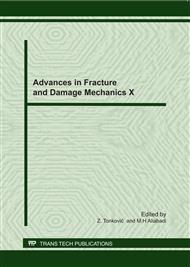p.122
p.126
p.130
p.134
p.138
p.142
p.146
p.150
p.154
Identification of Slant Cracks in a Cantilever Beam Using Design of Experiment and Neuro-Genetic Technique
Abstract:
Cracks present a serious threat to the performance of beam-like structures. In this paper, the flexural vibration of a cantilever beam having a slant crack is considered. The beam natural frequencies are obtained for various crack locations, depths and angles, using the finite element method. These natural frequencies and crack specifications are then used to train a neural network. The input of the neural network is the crack specifications and the output is five natural frequencies of the beam. With the trained neural network, genetic algorithm is then used to determine the beam crack specifications by minimizing the differences from the measured frequencies. Simulations are performed to evaluate performance of the neural network. Results show that the proposed scheme can detect slant cracks in cantilever beams with good accuracy.
Info:
Periodical:
Pages:
138-141
Citation:
Online since:
September 2011
Authors:
Price:
Сopyright:
© 2012 Trans Tech Publications Ltd. All Rights Reserved
Share:
Citation:


